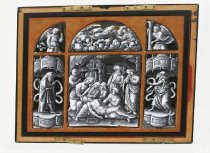Object Record
Images

Metadata
Catalog number |
64.20 |
Title |
Six panels from a devotional shrine |
Date |
ca. 1500 |
Object Name |
Shrine |
Description |
Private devotional shrine composed of six grisaille enamel panels forming a triptych; the central panel shows The Pieta; above this central rectangular panel hovers the figure of God the Father in a lunette; flanking panels each show a Prophet standing in a niche composed of a lobed base and baldachino; above the Prophets are angels with instuments of Christ's Passion, and the Prophets carry inscribed scrolls: on the left, "sol et Luna obt enebrti Sunt Venite et Descendie" [Joel 2], on the right, "Tollite me et mitte in Mare" [Jonas 2]; presumably the Prophets' drapery is rendered in a deliberate archaic style, to indicate that they come from a time before the central scene [NAW 1/92] Judging by its small size and fine quality, this enamel triptych altarpiece would have been used in the home of a wealthy Renaissance patron as a visual aid in private prayer. It was created in Limoges, an area known for its superior enamel workshops, at a time when Protestant attacks were challenging the production of this type of religious imagery. To counter these challenges, the papacy along with Ignatius Loyola and the Jesuits, following humanist-inspired movements such as the devotio moderna, began placing greater importance on highly emotional representations of biblical narratives, especially scenes of Christ's Passion. The scourge, the column, and instruments of the Passion are emphasized in the outer hemi-lunettes of this altarpiece, as well as the crown of thorns, which is prominently placed in the foreground of the central panel depicting the Lamentation. The high emotional content of Christ's Passion was ideal for objects of private devotion because it inspired the viewer to experience the depicted events as if he or she were present at the scene, prompting a deeper state of spiritual meditation and a more personal relationship to the divine through prayer. The scene of the Lamentation of Christ was also important in domestic devotional objects because of the prominent role of the Virgin and the emphasis on her maternal relationship to Christ. According to household inventories, these types of religious objects were often part of a woman's dowry, and images of the Virgin would represent a role model of piety, fidelity, morality, and maternity. Considering the high infant-mortality rate in the Renaissance, the scene's emphasis on the grief of the Virgin would have been especially important for these objects of private devotion, helping women draw spiritual strength from the intense sorrow of the Virgin Mother. Citation: Extract taken from essay by Laura Stevenson in "SCHOLARS, EXPLORERS, PRIESTS, How the Renaissance Gave Us the Modern World," ex. cat. G -T M, Queens College, CUNY, February 2 - March 27, 2010, 14. |
Medium/Material |
Enamel |
Dimensions |
H-13.5 W-15.75 D-1.75 cm |
Exhibition and Publication History |
* Exhibited Hillwood Art Museum, Mary at the 3rd Millennium, 2000 * "Director's Choice, Part II," G-TM, 10/10-12/20/02. A. Winter, Curator. * "SCHOLARS, EXPLORERS, PRIESTS, How the Renaissance Gave Us the Modern World," Curated by James M. Saslow, G -T M, Queens College, CUNY, February 2 - March 27, 2010, # 14, ill. |
Culture |
French/Limoges |

